4. Handling Your Audience and Guests
Controlling Outcomes
Video is great when it comes to communicating face to face. A planned or scheduled video call that is going to go live on-air in the Google+ environment and is also going to be recorded and made available, later, on YouTube is a great way to get a specific branding message across. It can become an easy way to introduce a new product, talk about a trend, introduce a service, or simply discuss the latest development within your industry.
Planned Hangouts on Air are basically events that can be promoted throughout the Google+ environment using the Events page, such as the example shown in Figure 4.1.
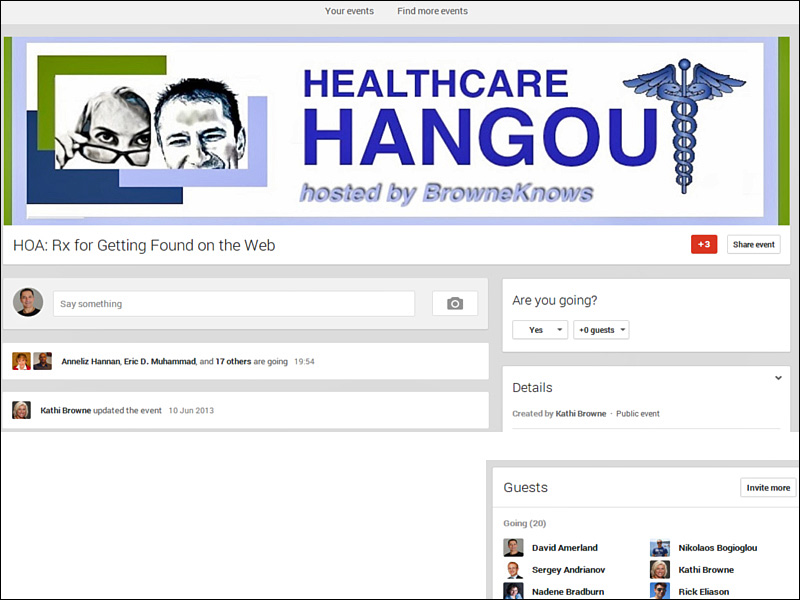
Figure 4.1 This is an event as it appears on the Google+ Events page. The moment an Event is created, it appears on the Events page of all invitees. They also receive notification in the Google+ notification icon in their profiles, though this is governed by a number of factors including the trust factor that the host has built up and the number of people invited.
Although Hangouts on Air are all largely unscripted in the sense that the conversation is free flowing and guests frequently add their own questions, setting some boundaries of what you will explore in the video call helps create a greater sense of confidence for the guests who participate in the HOA in terms of expected content. It also gives you the option to not answer questions when they fall outside the boundaries you have set.
Setting boundaries for your Hangout on Air is sensible for many reasons:
• It helps you establish the value proposition behind it (that is, why you are holding it in the first place and what the participants will gain by attending).
• It establishes you, from the outset, as the person who is in control. (It is your Hangout on Air, your rules.)
• It gives you an instant means to prevent anything from going wrong by moderating discussion within the stated boundaries. (This is particularly useful in Hangouts on Air when guests who participate might have their own agendas and their own experience of how a live event works.)
• It becomes part of your general branding strategy. (The way you conduct yourself in a Hangout on Air creates a very strong sense of the character and value proposition of your company or brand.)
So your first step when deciding to hold a Hangout on Air is to create the environment within which it is to happen. This requires running some short scenarios to help you visualize the desired outcome of your Hangout on Air (that is, what the message is that you want to get across, what brand values need to be projected, how lax or strict you will be with your guests, how much levity you will allow, and where you will need to draw the line and how). All of this helps boost your own confidence in what you will do and how you will conduct yourself, and, in turn, when you are live it projects and boosts the confidence of your guests.
Because you really do not know what you will need until you need it, it is always good practice to prepare a few things beforehand. If you are doing all or most of the presenting and speaking, filling in the time you have allotted is not a difficult thing to do. But if you are not then you are relying on other people’s ability to do so. Guests can sometimes freeze or their mind can draw a blank just when they need to say something. Nothing jars more than dead time in a live streamed event, so having some filler material at hand is always good practice.
Here are some examples of what you can prepare beforehand:
• If you have an interview subject, prepare some additional questions beforehand.
• If you are presenting things yourself, have a couple of fillers you can use if you are suddenly stuck for content.
• Either way, have at least one piece of material that is considered to be lighthearted. Remember that although the content of your Hangout will be important, it is also designed to make the audience feel good and its entertainment factor is critical.
• Have at least one piece of content, as a backup, that is really up to the minute. This helps maintain a sense of immediacy when you present it, and also, because it is current, it increases the possibility of audience participation when you need it.
One of the things to remember about controlling outcomes is that you also need to decide in advance on the format and style of your Hangout on Air. The medium is still new, the interactions are also new in terms of etiquette, and all we have as a guide are the rules of conduct of traditionally televised interviews (live or otherwise) that are obviously different.
There are a number of different formats you may want to consider in Hangouts:
• The solo interview—As the name suggests this is a Hangout on Air between a presenter and a solo guest. To pull it off, you usually require a guest of sufficient star power and a subject that is of particular interest to the audience.
• The panel interview—This is where a presenter is aided by a panel of co-presenters or supporting guests who assist in the HOA by asking questions or providing contextual information that helps the main HOA guest present his or her subject.
• The multi-guest show—Multi-guest shows feature a number of HOA guests who either come from the same industry background or have complementary knowledge. They take it in turns to address the issues and questions that the presenter asks.
• The Q&A show—Q&A Hangouts on Air are all about questions presented by the audience. Usually a HOA will be open to audience interaction through questions posed directly on the HOA Event page or YouTube. The Q&A HOA is based on audience questions right from the start. It presupposes that the subject matter is of sufficient interest to attract an audience in the first place, willing to ask questions. Or the guest happens to be of sufficient stature.
Which Hangout on Air you decide to go for will depend upon your experience, confidence, willingness to experiment, the subject matter, the type of audience you attract, and the kind of guests you can pull in.
In traditional broadcasting, sponsors are mentioned at the beginning of a TV show or at the end in the rolling credits. The audience is passive and relatively captive in the sense that the moment they are in front of a TV set, in their living room, there are not too many distractions vying for their attention.
The same cannot be said for the digital medium and Hangouts on Air. This makes any kind of branding or mention of sponsorship trickier.
That being said, the objectives for a HOA are still the same as those for any traditional broadcast:
• Attract and retain audience attention.
• Establish authority through quality content.
• Gain popularity through an appealing style of presentation.
The audience mindset, however, is more complex. While in a traditional TV set situation the audience may be killing time, online most people are actively engaged in a variety of activities, some of which will already have part of their attention (browsing content, answering emails). This makes it harder for a HOA to emulate the exact set up of a TV show where there is no active audience participation and still maintain a popular presence.
Hangouts on Air present some additional challenges. For starters, unless you’re the person talking, all anyone sees is a thumbnail of you displayed at the bottom of the screen, as shown in Figure 4.2.

Figure 4.2 The Hangout on Air environment requires a specific awareness of surroundings in order to create a branding message. When you’re the one who is talking, the screen you appear in depends on the device. When you’re not talking, you’re just a thumbnail at the bottom, as shown in the picture. So it is important to remember to avoid elaborate settings, have a clear visual of yourself, and provide good lighting.
This makes overly busy backgrounds, complex branding setups, and poor lighting conditions become even more of an issue than in a regular TV transmission.
Because Hangouts on Air rely on the stability of an Internet connection to work and because the quality of that connection will vary throughout the duration of a Hangout on Air, it is quite likely that the quality of the picture may sometimes drop during the Hangout on Air. Branding therefore has to rely on very clear, very literal props. Custom made backdrops with a logo, for instance, can work well.
In the television industry, a Lower Third is a graphic placed in the title-safe lower area of the screen, though not necessarily the entire lower third of it, as the name suggests. Within Hangouts on Air there is an option to create a Lower Third and add a logo to it or even create a customized Lower Third and upload it to the HOA.
Lower Thirds provide constant branding every time you speak on the main HOA screen. Again, it is up to you to decide just how you will use that time to promote your brand or display a sponsored logo or message. It is worth bearing in mind that a certain degree of subtlety in the HOA environment usually works best.
HOAs are now available to view in HD format. Obviously the quality of your connection speed will determine just how good the picture is, but at least it now has become possible to share slides and PowerPoint presentations without great loss of readability.
All of these elements feed into your control over the outcome of a Hangout on Air. The second part of making sure that a Hangout on Air is as smooth an experience as possible for the viewer depends on your ability to use the controls Google provides you with as the broadcaster. The next section deals with some of the technicalities of the Hangout on Air that you need to be aware of so that you can feel that you are in total control of what you’re setting out to do.
Setting Up Your HOA
Unless you feel like taking a chance and trusting in fate to help you get publicity, you need to plan your Hangout on Air as a coordinated marketing event. This includes a “Before,” “During,” and “After” stage with preparation every step of the way.
Before your Hangout on Air goes live, you will need to decide on the best time to hold it. This is the easy part because it will be dictated by the time zone of your target audience and the most suitable hours for them in that time zone.
On the Web you can reach any audience at any time if you are prepared to stay up late. That does not mean it is the right thing to do for your business. Decide first what it is you want to achieve. This will then determine who you are targeting. For example, a business that is based in Europe but wants to expand to the U.S. and is using a HOA as part of its marketing plan will need to do the following:
• Decide which part of the U.S. it is targeting (eastern standard time, as in New York, or pacific daylight time, as in Los Angeles) and determine its time zone.
• Work out the best time, in its target time zone, for its live audience. It makes little sense, for instance, to try to target stay-at-home moms at the 5:00 pm to 7:00 pm time slot when they are busy with kids and family matters and hardly have time to do anything else.
• Work out the peak times when visitors come to its website from the geographic area it’s targeting. The company will need to use its Google Analytics account for that. Google Analytics helps you understand your demographics a little better so you know whether those who come to your website know a little about you or are completely new visitors. This, then, also determines a little of the tone and content of the HOA. A market that is virgin territory will need more explanation than, say, a market that knows something of who you are.
After you have decided these three things, you will be able to determine the best time for scheduling a HOA. Now, you might ask here, quite rightly, if a HOA is recorded and it is then made available on YouTube for later viewing and it can be viewed at any time, why go to all this trouble to work out the best time for the target audience?
The answer lies in the simple fact that a live event also requires an interaction component. We will see shortly how to make use of a live audience to increase buzz and drive perception of brand power, but for now it is sufficient to say that a HOA that does not have a live audience is missing an opportunity to increase its marketing value.
So, considering that a live audience is necessary, the first thing you need to do is ensure that you publicize your event to them. Interestingly enough, although Google+ is going to be your primary venue, the publicity for the event can take place across all social media channels and your website. But let’s go and see first how you can achieve the publicity in Google+ using the Events feature, as shown in Figure 4.3.

Figure 4.3 Mousing over the Home icon when logged into Google+ brings up the functions that are available in a new navigation menu that slides out from the left of your screen. Click on Events to get started.
The Events Directory page lists all the Events that you have been invited to and it also lists whether you have clicked to say you are going to attend or are still thinking about it and so on, as shown in Figure 4.4. This is a handy reminder for your invited audience that helps them keep track of the events they have been sent. The ones who confirm that they will attend an Event by clicking Yes will then see that Event on their Google Calendar, as shown in Figure 4.5. They also will get a reminder sent to them on their mobile device 24 hours before the event and then 15 minutes before the event starts.
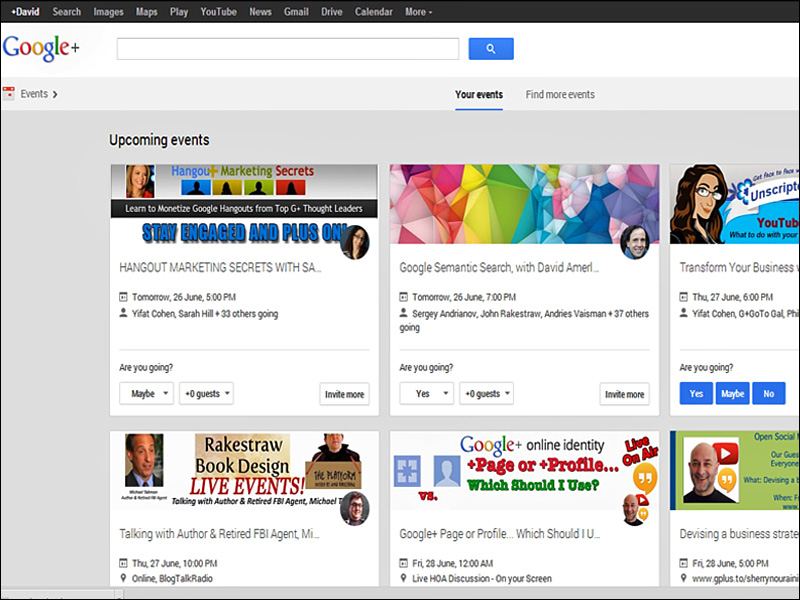
Figure 4.4 Events you agree to attend as a guest or as an audience are collected and shown on this Events Directory page and listed in chronological order. The Events Directory page is specific to you.

Figure 4.5 The Events you have decided to attend in any given week appear automatically in your Google Calendar. Grayed-out ones are Events that have already passed. Reminders are sent automatically to your mobile device.
The functionality of HOAs and Event settings is constantly being refined. You should not expect your HOA guests to be current. If you’re hosting HOAs you should always experiment with the functionality in order to be able to guide your guests when they set up to come into the HOA.
To set up the Event page for your Hangout on Air, follow these steps:
1. Use the left-hand side menu on Google+ and navigate to the Hangouts page. Click on the big blue button on the left that says “Start a Hangout on Air,” as shown in Figure 4.6.

Figure 4.6 This is also the page from which you could choose to share (or join) a video Hangout. On the right-hand side of that page is a green banner that takes you to the page where video Hangouts happening at that moment are listed.
2. When the dialogue box comes up click on the “Later” tab first. This will bring up the Calendar and Time options underneath. Click on the field box with the date to bring up the Calendar and choose the date you want to hold your Hangout on, as shown in Figure 4.7. When you have the date, fill in the starting and ending time of your Hangout on Air.
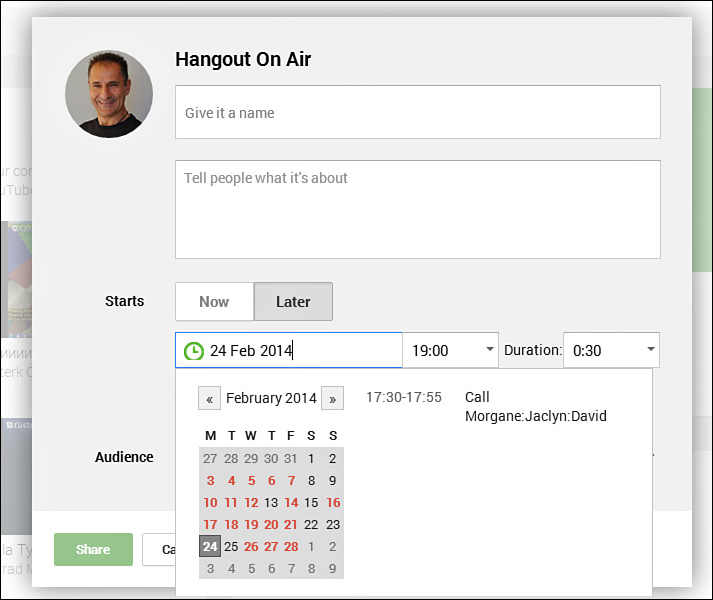
Figure 4.7 By choosing a date and time for your Hangout on Air, you are creating an Event page for it.
3. Next think of a great, catchy title for your Hangout on Air and enter it; titles here are important. Calling it, for instance, “Hangout with Me” (which I have seen) is not really a great option, even if you’re a media star. Some of the most popular Hangouts I have been to combine an action call in the title and an insight into the value proposition of the Hangout. Examples include the following:
• What is semantic search: a guide
• Working from Home Tips
• How to Market More Effectively
• Semantic search marketing for Interior Designers
You will notice that all of these titles tell a story. They make it very clear what the Hangout is about and what the participants should expect to gain from it. It is this approach to creating an instant payoff that allows those who see your notification of a Hangout to make a snap judgment, decide to go, and invite their friends, where suitable.
4. You can choose to put a description here immediately, but you do not have to. You can come back later and add that. Descriptions are important because they convince your audience of the value of your Hangout on Air. You can also include links in a description which can help take the audience that reads it to a specific website or Google+ profile. Writing a great description is part of the skill you bring to your marketing. Not only does it have to be enticing, pithy, and informative, but it also has to feed into your brand values of who you are and what you do, projecting your own unique voice. A little time spent crafting the description and examining it critically to make sure it works for you will pay off in terms of impact.
5. Consider your audience before you hit the “Share” button on your Hangout on Air. Understandably, you want to have as broad an audience as possible. To avoid spamming the streams of its members, Google+ does not allow you to invite the public to your Hangout on Air as you set it up. What you can do is have a specific circle of people you notify when you have a Hangout on Air who you can invite.
If you’re new to this, you can even invite a single person by mentioning them so you can complete the setting up of your Hangout on Air Event page and then deal with publicity afterwards. (I will cover some examples of this later in this chapter.)
6. Click “Share” and your Event page for your Hangout on Air will be complete. It will load and you will be taken to it. In Figure 4.8, I have an example Event page set up.
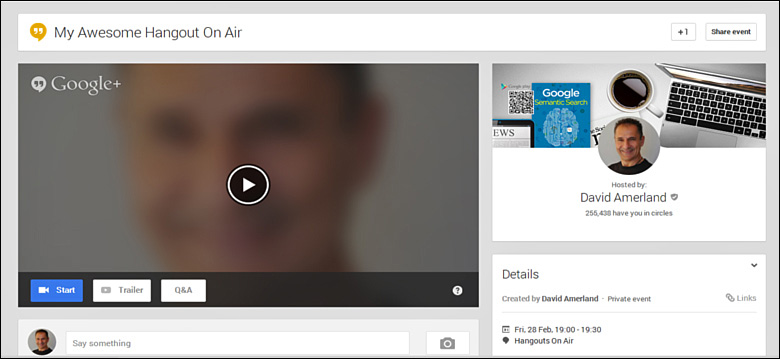
Figure 4.8 The Hangout on Air Event page provides you with a video pane. When clicked, it will give a countdown timer to the day and time of the planned Hangout on Air. If you want, you can choose to upload a trailer to introduce it to your audience.
7. On the right hand side on the pane marked Details, there are two important functions. If you click on the little arrow, you will get a drop down box. One of the commands there is “Edit Event.” Clicking on it takes you to the Event Editor, shown in Figure 4.9, where you can add in a description (when you have prepared it) and add a customized Header for the Event. The dimensions for that image are 2120 × 630.
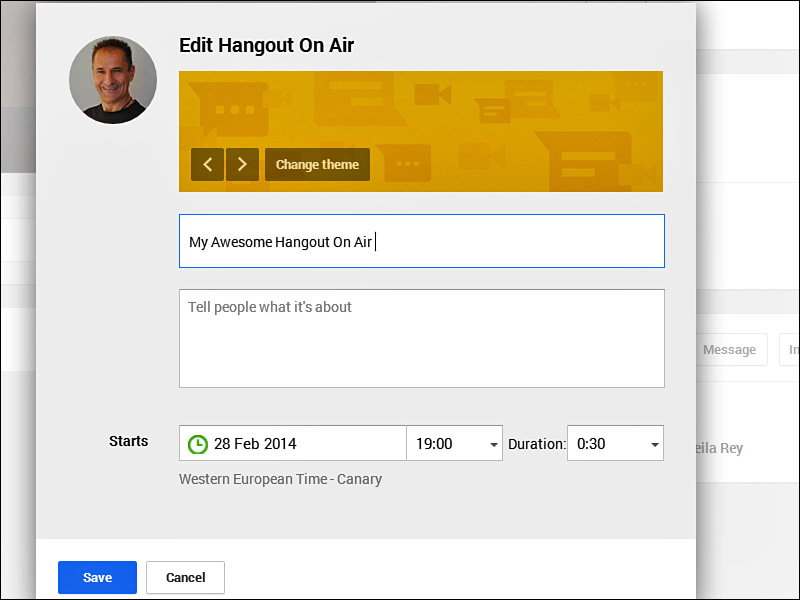
Figure 4.9 The Event Editor allows you to edit the Event page of your Hangout on Air, add a header (or use one of the ones provided), add a description, or change the time.
When your Hangout on Air Event page has been set up, the question becomes, how do you publicize it? Do you just blast it out to the world and hope for the best or do you take a more considered, planned approach that factors in the character of your audience?
Well, obviously, after you’ve done all the work of planning it and organizing your guests, the last thing you really want to do is to leave the future success of your Hangout to chance. So, once more, you need to plan how you will invite people to attend.
The first rule, of course, is that you never invite people just a day before it’s about to happen and hope they can make it. That really is too short a notice and it negates the entire point of the scheduled Hangout on Air, which is designed to allow people to decide to set time aside for it. A sense that it is too soon to really plan around is only more likely to make them say no to attending.
When it comes to the actual invitation, there are two ways this can be done: First, you can go on the Event page of your Hangout on Air, click on the “Share Event” button on the top right hand side and share that Event with the Public on the Google+ stream. Second, you can go through those people who follow your Google+ Page (or Google+ Profile) and handpick those most likely to benefit from your specific Hangout on Air. You can then place these targeted profiles in a Circle and use that Circle to launch the first wave of publicity for your Hangout on Air.
If you are a member of a particular Google+ Community or Communities whose members will benefit from the Hangout, these should come next on your list to notify.
When it comes to sharing the Event page for your Hangout on Air there are a few things you need to keep in mind:
• Add context. Do not just reshare an Event and hope that people will respond. Go to the trouble to write an introduction that catches their attention, fires up their excitement, and makes them want to attend. (Here’s an example of the way I publicized a Hangout on Air I attended: http://goo.gl/CKpl3X.)
• Add value. Don’t be too cryptic in your communication with your audience. Be quick to tell them what they will gain by watching this Hangout on Air. This way they’ll be more likely to make the decision that’s best for them. (See how I publicized a Hangout on Air I hosted for the Social Media Today PowerTalk series: http://goo.gl/CQb6dP.)
• Make it fun. Just because the subject may be important does not mean it cannot have an element of fun in it. Without breaking into jokes, you can include aspects that touch upon the popular sentiment. (Here’s how I publicized a Hangout on Air for NetApp where I was one of the guests debating the issue of whether CEOs should blog: http://goo.gl/6iB7QF.)
Hangouts and Hangouts on Air are a powerful means of communication. This also makes them perfect for marketing, provided you understand how to use them. In the next chapter we will examine how a single Hangout on Air can be used to provide as much marketing mileage and exposure as possible.
What You Learned in This Chapter
After you have become familiar with the Hangouts on Air, you will most probably find yourself looking for opportunities to hold one. As with everything else, it just takes a little practise and the Google+ environment is pretty forgiving of the odd glitch.
Here’s what I hope you learned in this chapter:
• Control of outcomes in Hangouts on Air depends on planning. Although the environment is forgiving and the platform allows you a lot of control, you still need to plan for every eventuality.
• Hangouts on Air allow you to target your audience very precisely. They are a powerful connecting tool that can massively help project your brand image and brand value. Make sure you pick the right time zone and target the right audience.
• Hangouts on Air require a little time to set up properly and need to be marketed well in advance in order to be effective.
• Branding in a Hangout on Air requires a deft, minimalist touch with uncluttered backgrounds and a clear message, delivered through content.
• You can have a “Hangouts on Air” Circle, which you use to invite an audience that specifically wants to attend a Hangout on Air.
